These easy cheddar cheese and chives scones come together in a matter of minutes. Flavored with cheddar cheese, chives, and a hint of black pepper, enjoy these scones hot out of the oven with a smattering of butter.
Savory scones have a special place in my heart. What we call savory scones in many of the Commonwealth Countries such as South Africa, New Zealand, and Australia are similar to what our friends in North America refer to as biscuits.
This cheddar chives scone recipe is based on my cheese scones and classic English scones recipes.
These cheddar chive scones can be enjoyed warm out of the oven, on their own, or with some extra butter and grated cheese or jam or they can be served at room temperature.
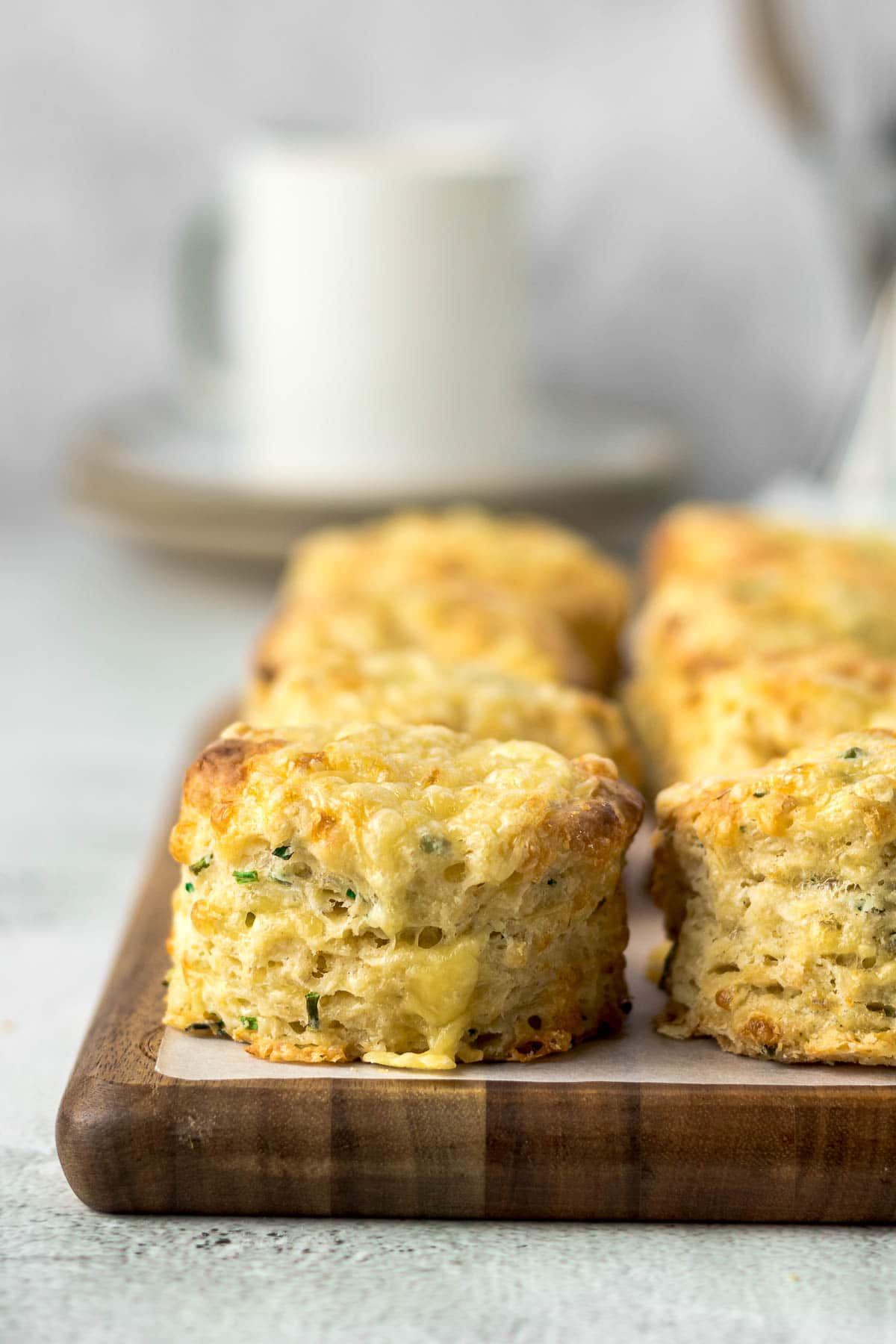
Jump to:
Ingredients
Flour - plain flour, standard grade, or all purpose flour is used to make these cheese scones. You can replace the plain all-purpose flour with self-raising or self-rising flour, but you will still need to add an additional ½ teaspoon of baking powder.
Baking Powder to give the scones a bit of lift during the baking. Make sure your baking powder is fresh by placing a ¼ to ½ teaspoon into a heat-proof container, then pouring some boiling water into it. If it fizzes, then the baking powder is still fresh.
Cold Butter (salted) adds flavor and gives a flakey tenderness to the scones. As the scones bake, the steam released from the butter raises the scone (in conjunction with the baking powder) and leads to a flakey, soft, and fluffy scone. I use New Zealand butter in all my recipes which is similar to European or Irish Butter.
Cheddar - I like using mature or vintage cheddar cheese when making scones as the flavor is just more pronounced, however, you can use a regular cheddar or tasty cheese (in New Zealand.) To add even more flavor to these scones, substitute 60 grams of the cheddar with some parmesan, Parmigiano Reggiano, or Grana Padano.
Fresh Chives add a nice mild oniony flavor to these scones. For something a bit different - swap out the chives with spring or green onions or scallions.
Milk adds moisture to the scones. I like to use a full-fat or whole milk for scones, but you can use a trim or 2% milk if that is what you have in the house.
Black pepper adds a nice depth of flavor and a bit of spiciness to the scones.
There is no added salt in this recipe as cheese can be rather salty. But if you have used unsalted butter and feel the cheese needs a bit more salt, you can add in a ¼ - ½ teaspoon for good measure.
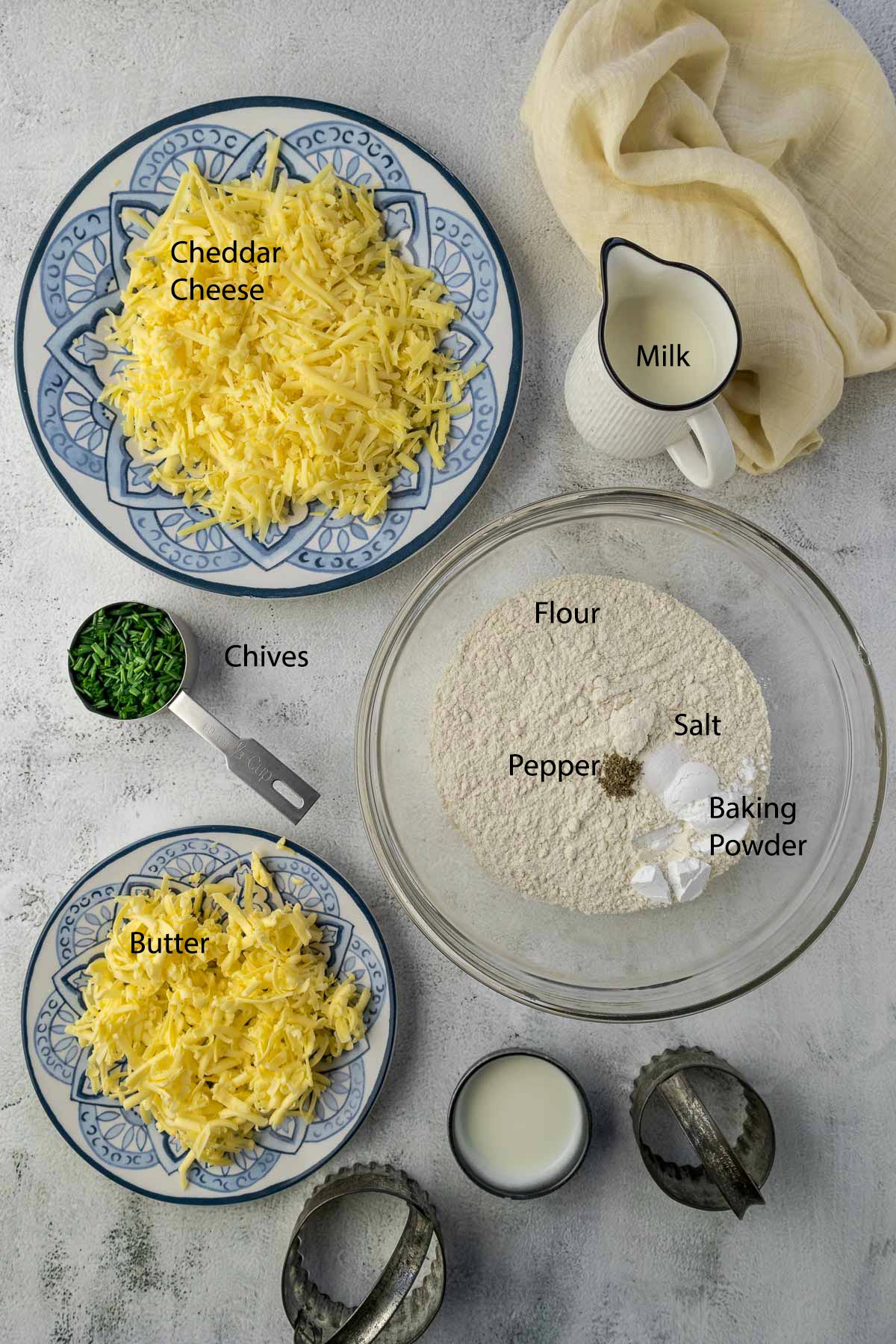
Step-By-Step Instructions
Note - all ingredients must be cold for this recipe. Grated butter and cheese can be stored in the fridge while other ingredients are measured and prepared.
Step 1 - Preheat the oven to 220°C/425F/Gas Mark7. Line a baking tray or baking sheet with parchment paper or baking paper.
Step 2 - Grate the cheddar cheese, keeping aside approximately 40 grams to place on top of the scones before baking.
Step 3 - In a large mixing bowl, whisk together the dry ingredients (flour, baking powder, salt, and black pepper).
Step 4 - Either grate the butter or cut it into small blocks. Rub the butter into the flour until it resembles coarse breadcrumbs with small pea-sized pieces of butter in the flour. This can also be done using a pastry cutter.
Step 5 - Add the grated cheese and chives to the flour mixture, and stir through until well-distributed.
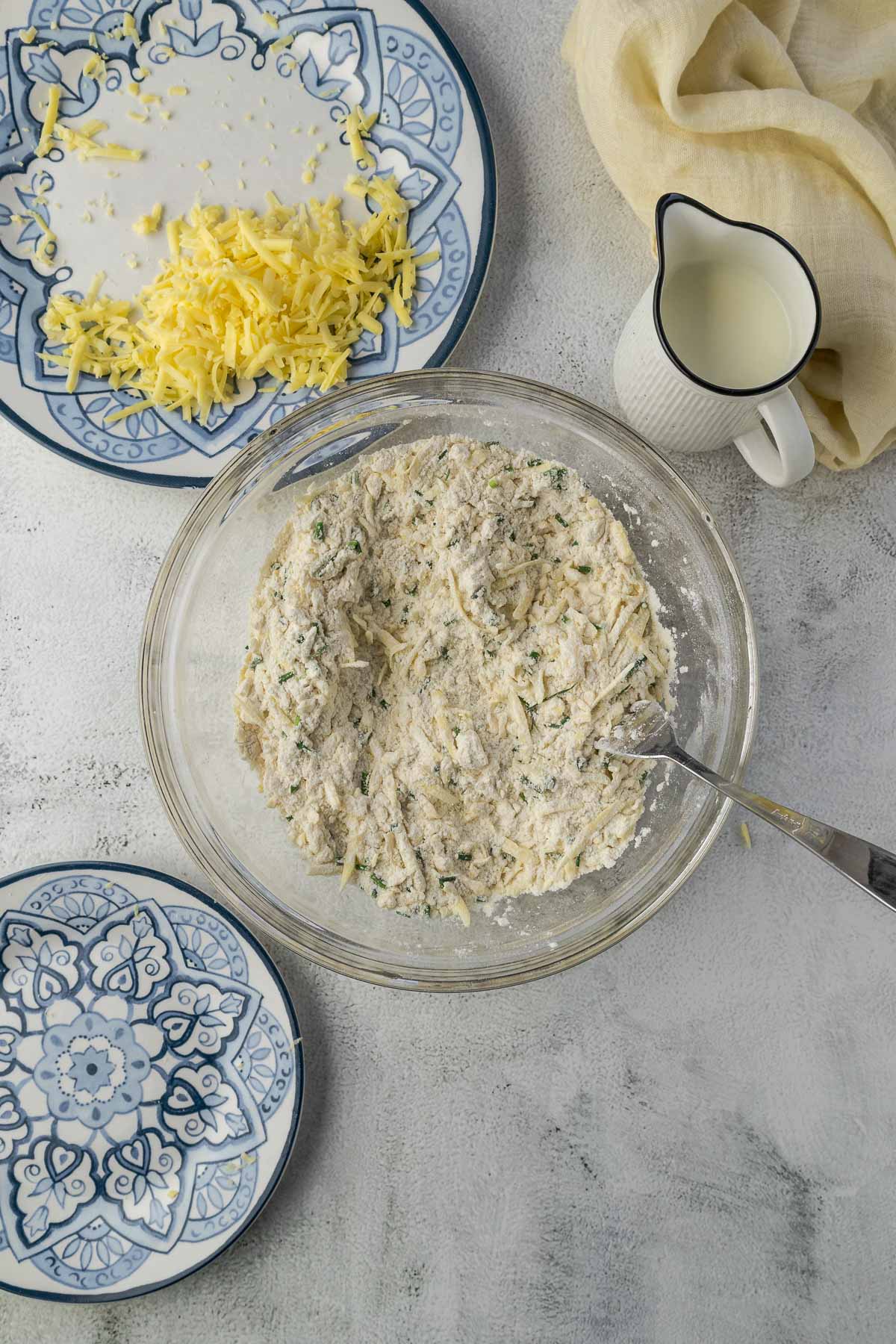
Step 6 - Pour the milk into the flour mixture, using a fork, and stir to make a rough dough.
Step 7 - Lightly flour a clean surface. Place the scone dough in the middle of the lightly floured surface and bring the dough together into a rectangle. Using a knife or bench scraper, cut the dough into thirds and fold the outer edges on the middle section. Press down using your hands or a rolling pin until the dough is about 3cm thick. Repeat the process twice more. This laminates the dough.
Step 8 - Either using a cookie cutter or knife, cut 6 to 8 large scones. If using a round cookie cutter, bring together the left-over dough, by gently kneading the dough together and forming a disk or square to cut out additional scones. Try to work with the dough as little as possible.
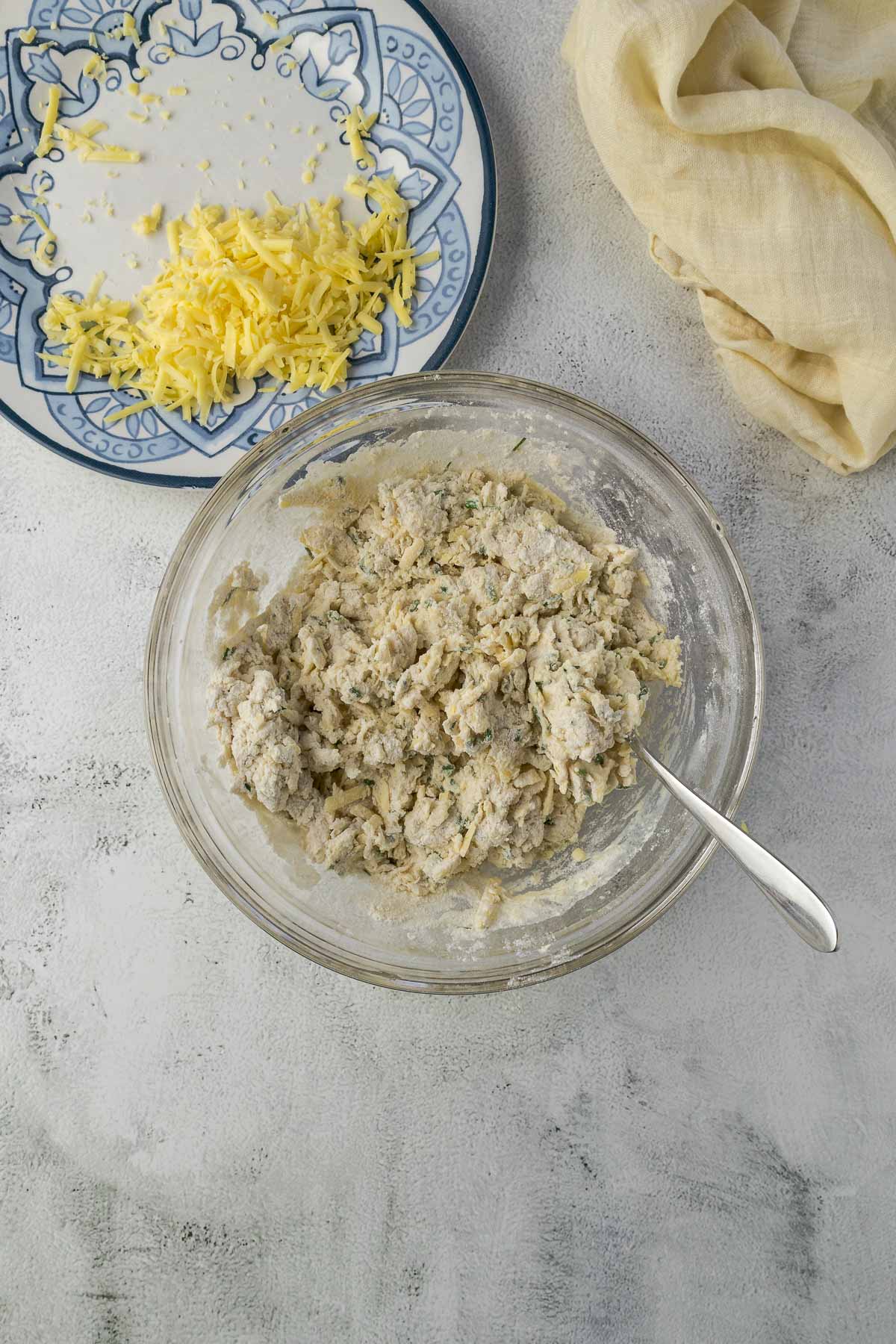
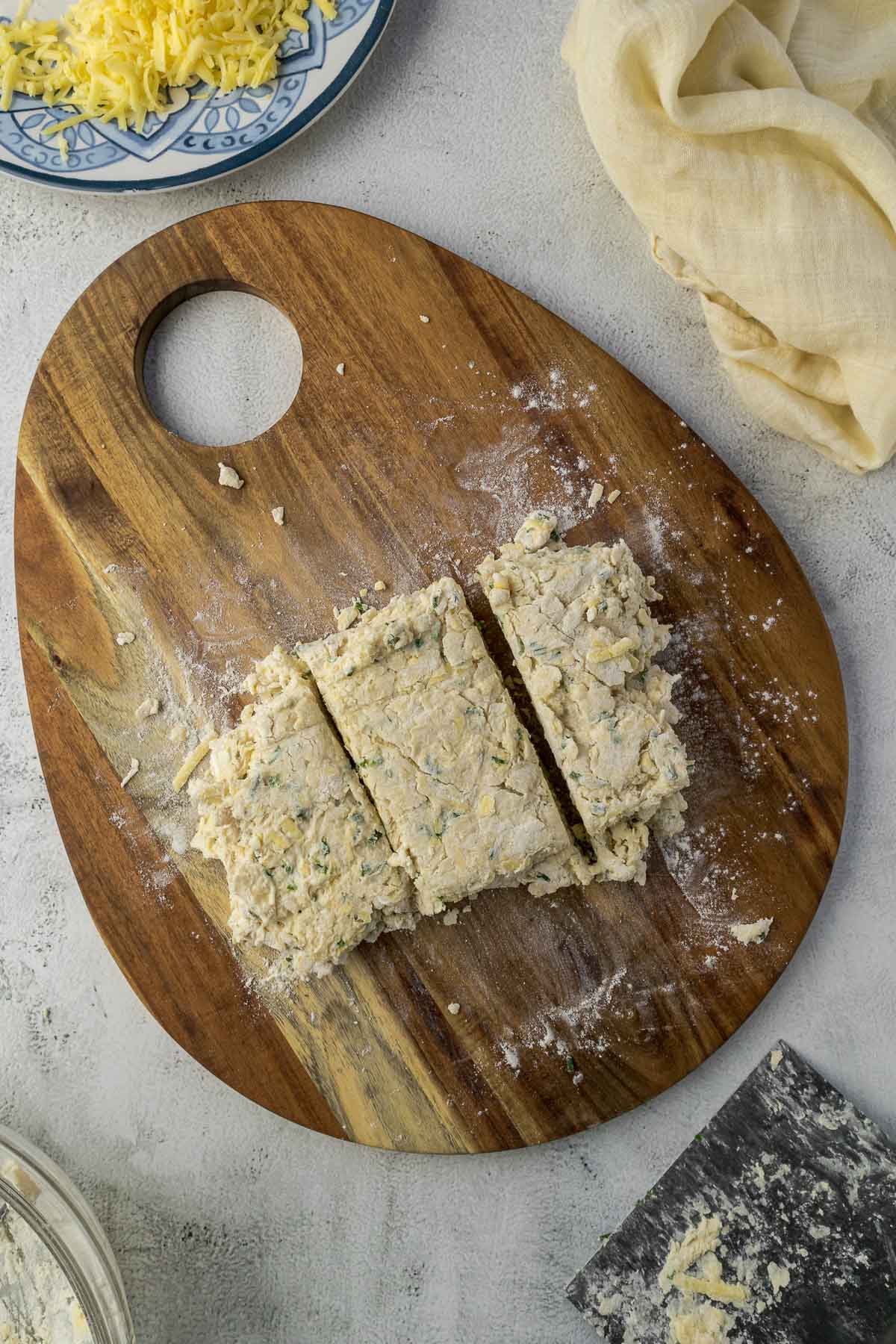
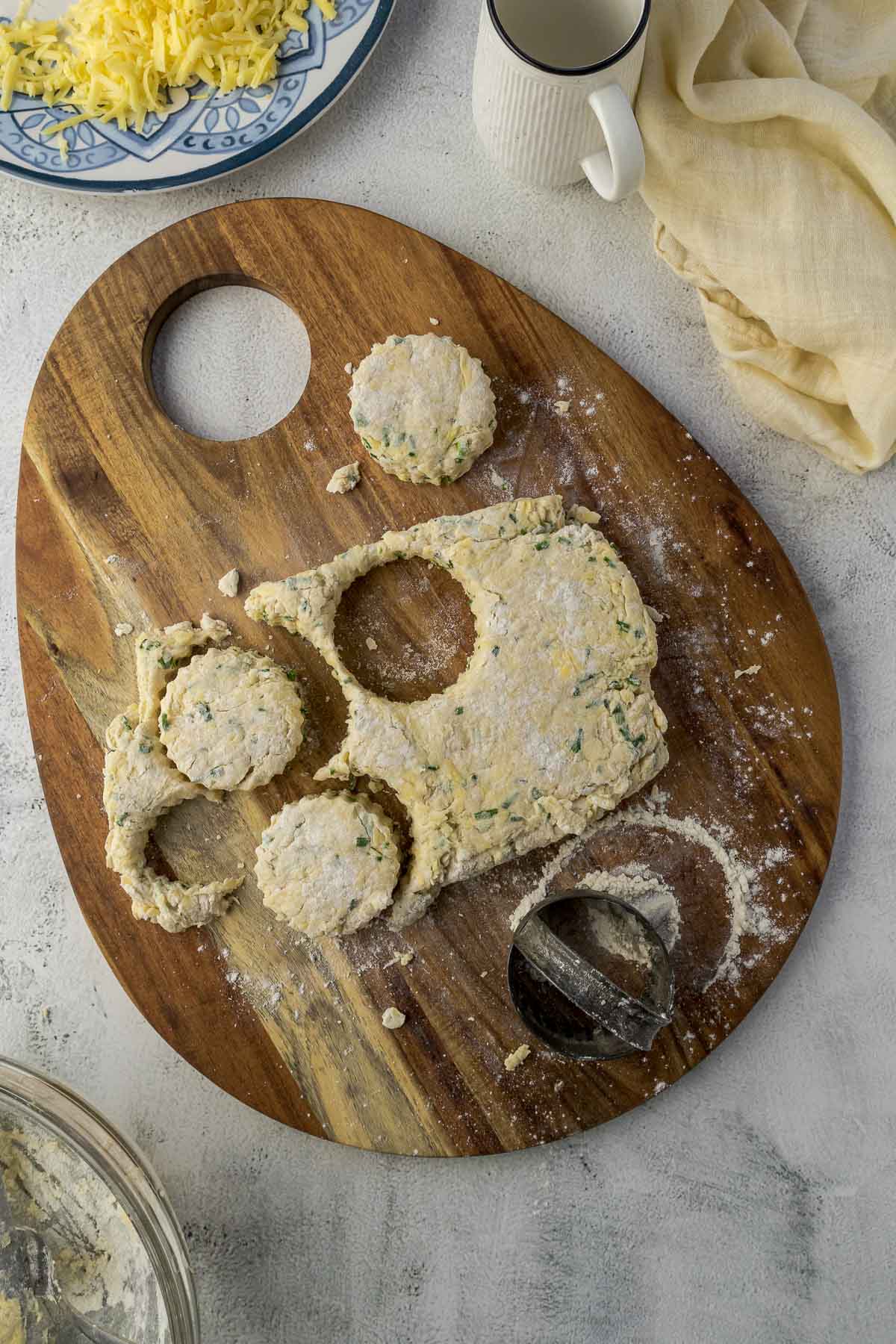
NOTE - for mini cheese and chives scones, simply divide the dough into 12-16 smaller pieces. Bake for 8 to 10 minutes.
Step 9 - Place the scones onto the prepared baking sheet. Then brush the tops of the scones with milk using a pastry brush, and sprinkle the leftover cheddar cheese on the tops of the scones.
Step 10 - Bake the scones in a preheated oven for 15 to 20 minutes. The scones would have risen and be a nice golden brown when they were done. Remove from the oven, and place the scone on a wire rack to cool down slightly before serving.
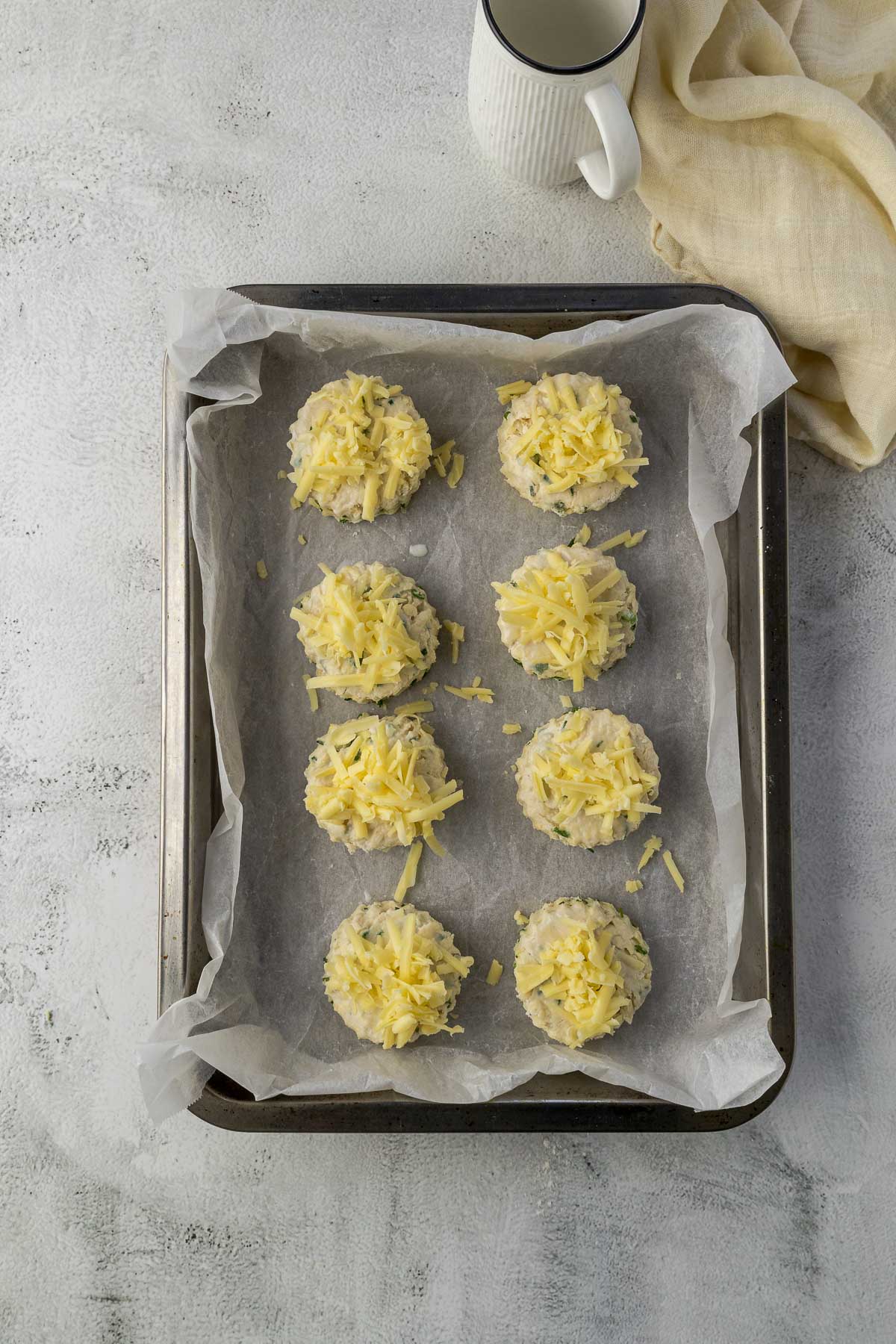
Expert Tips for this Recipe
- Weigh out your ingredients with a kitchen scale. This is the most accurate way to bake.
- Use cold ingredients when making scones. Keep all the ingredients in the fridge until you are ready to make these cheese and chive scones.
- Grate the cheese and butter (or cut into small blocks) ahead making the scone dough, and store them in the fridge while you are preparing everything else.
- If it is particularly warm - chill your bowl and utensils in the fridge for 30 minutes before you get going.
- Handle the scone dough as little as possible - this will result in a delightful tender scone. I like using a bench scraper to keep my warm hands off the scone dough.
- When gathering up any scraps of dough, try to laminate them together.
- Laminating the dough creates a nice layer of butter and cheese, and adds to the flakiness of the scone. And I find that during the lamination process, the dough becomes nice and cohesive without too much handling with my hands.
- To make mini scones - simply divide or cut the dough into 12-16 smaller pieces. These will take about 8 to 10 minutes to bake.
- If you feel the weather is a bit warm or are waiting for the oven to fully preheat, pop the scones on the baking tray into the fridge.
- If preparing the scone dough the night before, simply place the cutout scones on a baking tray lined with baking paper, and cover them with cling film or plastic wrap. Bake directly from the fridge once the oven is fully preheated.
Ovens and Air-Fryers
The temperatures stated are for conventional ovens. For convection, fan-forced, fan-assisted, or air-fryers, the temperature must be reduced by 20°C/25°F.
For baking, make sure the oven is fully preheated, and that the rack is in the middle of the oven. A fully preheated oven is essential for tall flaky scones. The high heat
Storage and Freezing
Scones can be stored at room temperature in an airtight container for 3 days. Frozen scones (baked or unbaked) can be stored for up to 3 months.
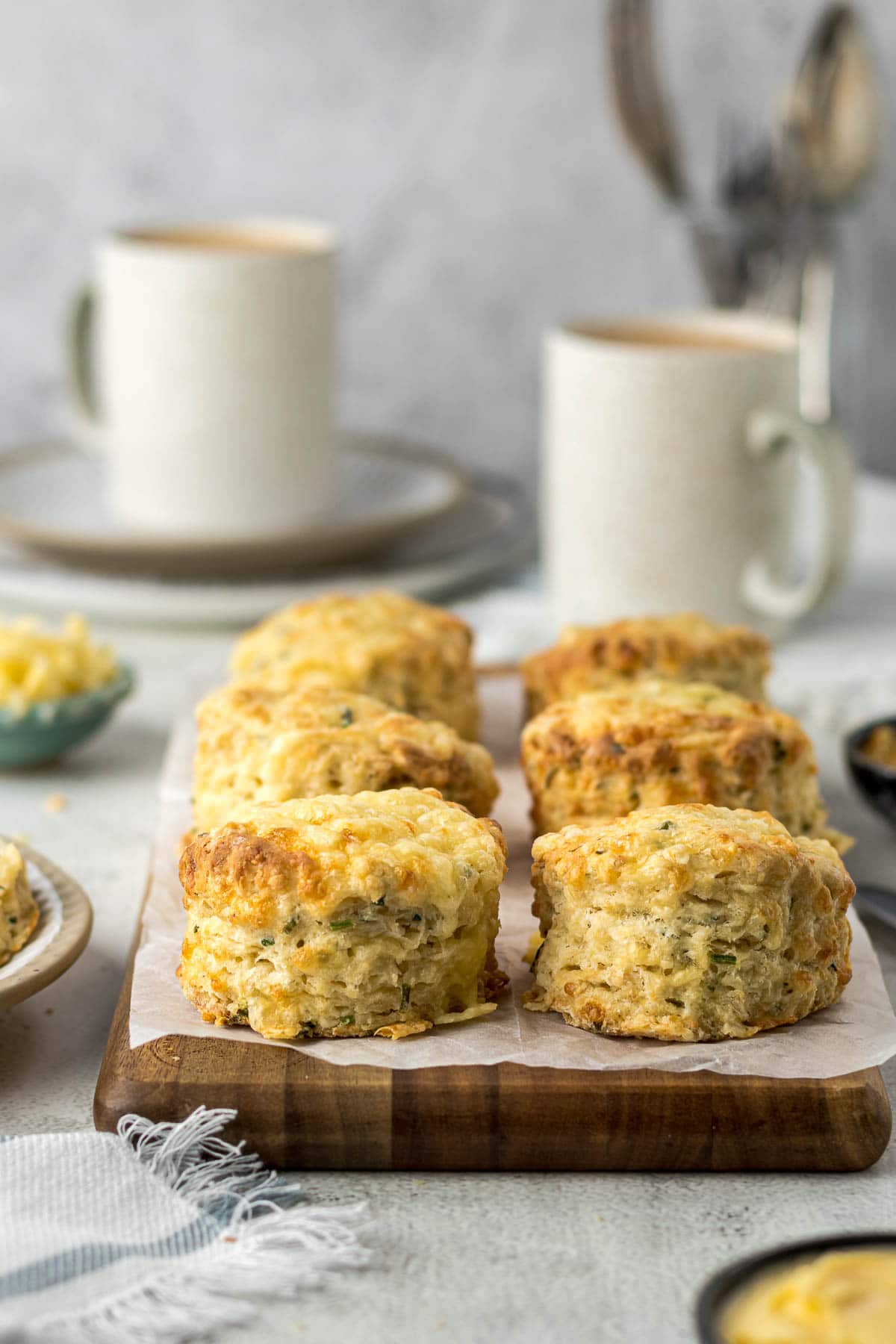
Cheese and Chives Scones FAQ
Yes. Allow the scones to cool completely before wrapping them in plastic wrap and in an airtight container. Scones can be frozen for up to 3 months. Defrost overnight in the fridge. Scones can also be baked directly from frozen, add 5 minutes to the baking time.
Strong-tasting cheeses like mature or vintage cheddar, and tasty cheese in New Zealand do very well.
Microwave day-old scones for 10-20 seconds next to a small bowl of water. Or place in a 150°C/ 300F/Gas Mark 2 oven for 5 minutes with a bowl of water to add some moisture back into the scones.
The scone dough has been overworked. Scones come out best when the dough is handled as little as possible.
Yes. Make the dough, cut out the scones, and place in the fridge overnight (in an airtight container). Bake the scones directly from the fridge.
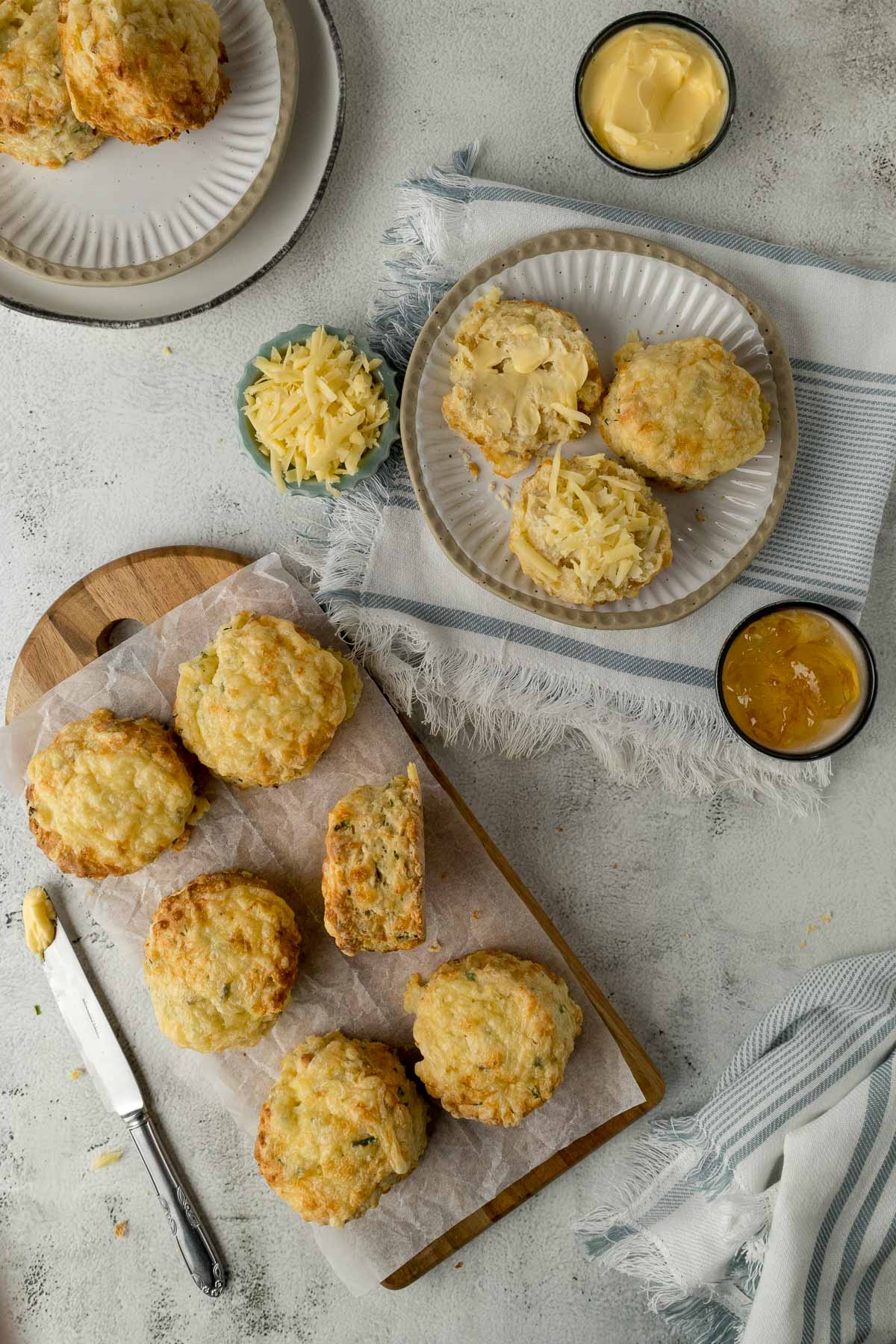
Rate & Review!
If you made this recipe, please leave a star rating! It gives my readers and me helpful feedback. If you want more recipes, subscribe to my newsletter, and follow me on Instagram, Pinterest, and Facebook!
Recipe Card
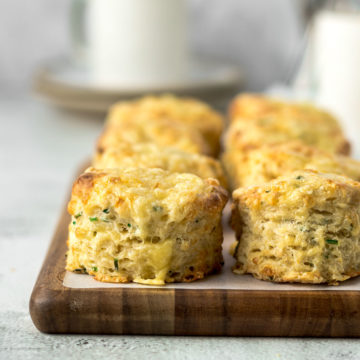
Cheddar Cheese and Chives Scones
Equipment
- Baking Tray
- Bench Scraper
- Mixing Bowls
- Pastry brush
- Cookie Cutters
Ingredients
- 160 grams cheddar cheese (grated)
- 300 grams plain flour (all-purpose/standard grade)
- 3 teaspoons baking powder
- ¼ - ½ teaspoon of table salt (if using unsalted butter)
- ½ teaspoon cracked black pepper
- 60 grams butter salted
- 200 mL milk
- 3 tablespoons milk
- ⅓ cup finely sliced chives
Instructions
- Preheat the oven to 220°C/425F/Gas Mark7. Line a baking tray or baking sheet with parchment paper or baking paper.
- Grate the cheddar cheese, keeping aside approximately 40 grams to place on top of the scones before baking.160 grams cheddar cheese
- n a large mixing bowl, whisk together the dry ingredients (flour, baking powder, salt, and black pepper).300 grams plain flour, 3 teaspoons baking powder, ¼ - ½ teaspoon of table salt, ½ teaspoon cracked black pepper
- Either grate the butter or cut it into small blocks. Rub the butter into the flour until it resembles coarse breadcrumbs with small pea-sized pieces of butter in the flour. This can also be done using a pastry cutter.60 grams butter
- Add the grated cheese and chives to the flour mixture, and stir through until well-distributed.⅓ cup finely sliced chives
- Pour the milk into the flour mixture, using a fork, and stir to make a rough dough.200 mL milk
- Lightly flour a clean surface. Place the scone dough in the middle of the lightly floured surface and bring the dough together into a rectangle. Using a knife or bench scraper, cut the dough into thirds and fold the outer edges on the middle section. Press down using your hands or a rolling pin until the dough is about 3cm thick. Repeat the process twice more. This laminates the dough.
- Either using a cookie cutter or knife, cut 6 to 8 large scones. If using a round cookie cutter, bring together the left-over dough, by gently kneading the dough together and forming a disk or square to cut out additional scones. Try to work with the dough as little as possible.
- Place the scones onto the prepared baking sheet. Then brush the tops of the scones with milk using a pastry brush, and sprinkle the leftover cheddar cheese on the tops of the scones.3 tablespoons milk
- Bake the scones in a preheated oven for 15 to 20 minutes. The scones would have risen and be a nice golden brown when they were done. Remove from the oven, and place the scone on a wire rack to cool down slightly before serving.
Notes
Storage and Freezing
Scones can be stored at room temperature in an airtight container for 3 days. Frozen scones (baked or unbaked) can be stored for up to 3 months.Nutrition
Nutrition information is an estimate. If scaling the recipe remember to scale your cook and bakeware accordingly. All temperatures stated are conventional, unless otherwise stated. Recipes tested in grams and at sea level.

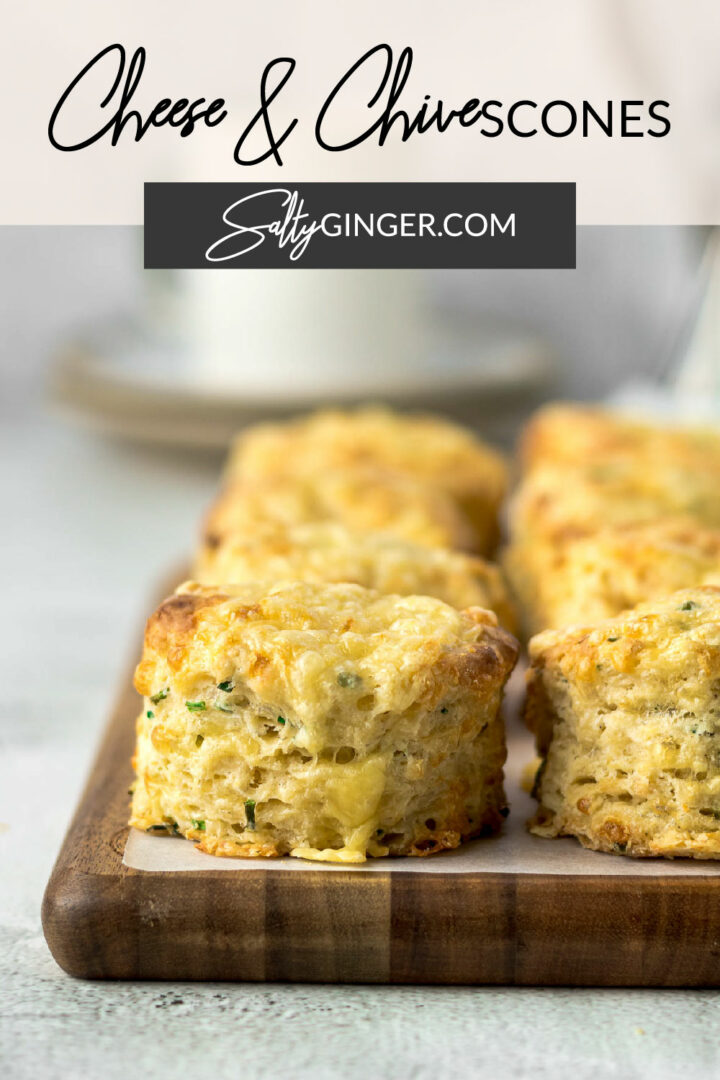
Mandi Koch says
Hi there I will be making this for Christmas morning. Please can you kindly advise if these scones freeze well.
Thank you
Mary-Lou says
Hi,
Scones can be stored at room temperature in an airtight container for 3 days. Frozen scones (baked or unbaked) can be stored for up to 3 months.
Do scones freeze well? Yes. Allow the scones to cool completely before wrapping them in plastic wrap and in an airtight container. Scones can be frozen for up to 3 months. Defrost overnight in the fridge. Scones can also be baked directly from frozen, add 5 minutes to the baking time.
Regards,
ML
Domi says
Delicious☺️